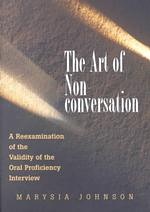

[ p. 11 ]
| Characteristic | "Typical" classroom contexts | OPI contexts |
| Turn-taking | Teacher-controlled | Typical pattern-question is turn point for conversation; timing, direction dominated by rater / teacher |
| Repair | Teacher dominates feedback and pre-empts students' self-repair | Repair is generally self-initiated; the OPI format expressly prohibits corrective feedback because errors help to discriminate ceiling performance |
| Topic | What is discussed is irrelevant, the process (how) is critical | Topic changes are contrived, arbitrarily driven by the rater's agenda and choice; topics were treated so formally and had so little relatedness to each other it seemed as though the topic list was chosen ahead of time; tended to extreme insensitivity in some instances (asking Iraqi refugee to comment on Hussein's regime; immigrant to comment on victimology) |
| Question type | Display and comprehension questions dominate | Predominantly information-seeking / checking, with the candidates occasionally requesting clarification; check / probe-expert questions meant to check baseline performance (floor) and probe for potential, conducted as a formal verbal exchange without any negotiation |
| Discourse unit | Teacher talk | Overwhelmingly question and answer unit, with some variance in the warm-up stage |
[ p. 12 ]
– Reviewed by Gerry Lassche
Miyagi Gakuin Women's University
[ p. 13 ]